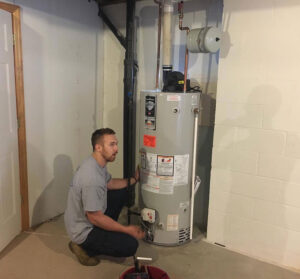Water Heater Installation Process
Mr. Waterheater specializes in residential and commercial water heater replacements and repairs. We take care of all your water heater needs, including water pressure regulators, expansion tanks, water shut-off valves, and any other plumbing item related to the water heater. “Waterheater” is our name, so when it comes to your water heater, why call anyone else?
Our Standard Installation is defined as the replacement of an old water heater with a new one, provided there is clear access to the old water heater.
We connect to your existing water, gas, and/or electric, and venting as long as it is all up to code. If we find anything is out of code, we will advise you of the recommended updates. There is an additional charge for updates.

Standard Installation of a water heater includes:
-
We shut off the water, gas and/or electric, then drain and disconnect your old water heater.#1
-
We remove the old water heater and place the new one in the same location.#2
-
If up to code, we reconnect the new water heater to the existing water lines, gas line and/or electric and venting.#3
-
For copper water lines, we include up to 1 foot of copper for minor changes at no additional charge. Additional copper will result in an additional charge.
-
For plastic water lines, many local plumbing codes require a certain length of copper from the top of the tank. If you have copper coming out of your existing tank and meet the local plumbing code, there is usually no additional charge. If your current set-up does not follow local plumbing code, there may be an additional charge.
-
We check the incoming water pressure and for thermal expansion.#4
-
We will advise if a pressure regulator and/or an expansion tank is needed.
-
We haul the old water heater for a minimal charge, or we put it at the curb at no additional charge.#5
-
The new water heater box is cut and placed at your curb.
-
The labor warranty for all water heaters, water pressure regulators and expansion tanks installed by our technicians is 1 year. You choose the warranty for the water heater tank and parts (warranties typically range from 6 through 12 years.)#6
Some examples of a non-standard installation include: (1) when the water heater is not located in the basement, (2) when the tank is not completely accessible, for example it is behind a furnace, under a counter, in a closet, behind a finished wall or door frame, or (3) when gas lines are blocking it.



